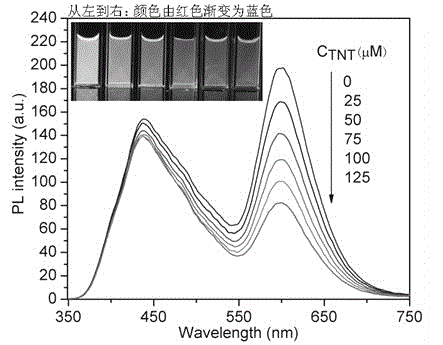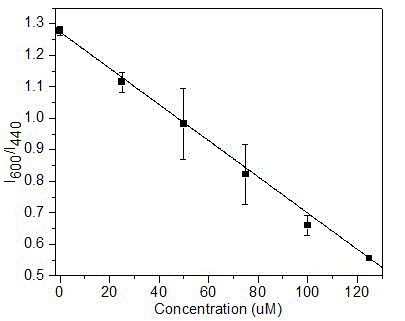Double-color nanocomposite as well as paper sensor for visually detecting trinitrotoluene based on composite and manufacturing method thereof
A nanocomposite and sensor technology, applied in material excitation analysis, fluorescence/phosphorescence, etc., to achieve the effect of omitting the pretreatment process, good selectivity and remarkable effect
- Summary
- Abstract
- Description
- Claims
- Application Information
AI Technical Summary
Problems solved by technology
Method used
Image
Examples
Embodiment 1
[0031] 1. Preparation of functionalized luminescent graphene oxide and manganese-doped nanocrystals
[0032] 0.2 mg of acyl-chlorinated graphene oxide and 2 mL of hexamethylenediamine were heated at 60 °C under the protection of nitrogen. After 72 hours of reaction, the heat source was removed and cooled to room temperature. Then the reacted graphene oxide is extracted to obtain amino-functionalized blue fluorescent graphene oxide. 50 mmol of zinc nitrate was dissolved in 40 mL of deionized water, and then 6 mmol of manganese acetate was dissolved in the above solution, ultrasonically dissolved completely, and then refluxed with dry nitrogen for 0.5 h to remove oxygen in the solution. Dissolve 50 mmol of sodium sulfide in 10 mL of deionized water, add drop by drop to the above boiling mixture, reflux and vigorously stir for 2 h. After cooling, centrifuge to obtain manganese-doped zinc sulfide nanocrystals, and ultrasonically disperse them in water. Then about 0.1 g of nanocr...
Embodiment 2
[0038] 1. Preparation of functionalized luminescent graphene oxide and manganese-doped nanocrystals
[0039] 1 mg of acyl-chlorinated graphene oxide and 2 mL of ethylenediamine were heated at 60 °C under the protection of nitrogen. After 48 hours of reaction, the heat source was removed and cooled to room temperature. Then the reacted graphene oxide is extracted to obtain amino-functionalized blue fluorescent graphene oxide. 10 mmol of zinc nitrate was dissolved in 40 mL of deionized water, and then 0.5 mmol of manganese acetate was dissolved in the above solution, sonicated to dissolve completely, and then refluxed with dry nitrogen for 1 h to remove oxygen in the solution. Dissolve 10 mmol of sodium sulfide in 10 mL of deionized water, add dropwise to the above boiling mixture, reflux and vigorously stir for 3 h. After cooling, centrifuge to obtain manganese-doped zinc sulfide nanocrystals, and ultrasonically disperse them in water. Then about 0.1 g of nanocrystals were di...
Embodiment 3
[0045] 1. Preparation of functionalized luminescent graphene oxide and manganese-doped nanocrystals
[0046] 2 mg of acyl-chlorinated graphene oxide and 2 mL of ethylenediamine were heated at 60 °C under the protection of nitrogen. After 48 hours of reaction, the heat source was removed and cooled to room temperature. Then the reacted graphene oxide is extracted to obtain amino-functionalized blue fluorescent graphene oxide. 5 mmol of zinc nitrate was dissolved in 40 mL of deionized water, and then 7.5 mmol of manganese acetate was dissolved in the above solution, ultrasonically dissolved completely, and then refluxed with dry nitrogen for 1 h to remove oxygen in the solution. Dissolve 5 mmol of sodium sulfide in 10 mL of deionized water, add drop by drop to the above boiling mixture, reflux and vigorously stir for 4 h. After cooling, centrifuge to obtain manganese-doped zinc sulfide nanocrystals, and ultrasonically disperse them in water. Then about 0.1 g of nanocrystals we...
PUM
| Property | Measurement | Unit |
|---|---|---|
| concentration | aaaaa | aaaaa |
Abstract
Description
Claims
Application Information
 Login to View More
Login to View More - R&D
- Intellectual Property
- Life Sciences
- Materials
- Tech Scout
- Unparalleled Data Quality
- Higher Quality Content
- 60% Fewer Hallucinations
Browse by: Latest US Patents, China's latest patents, Technical Efficacy Thesaurus, Application Domain, Technology Topic, Popular Technical Reports.
© 2025 PatSnap. All rights reserved.Legal|Privacy policy|Modern Slavery Act Transparency Statement|Sitemap|About US| Contact US: help@patsnap.com



